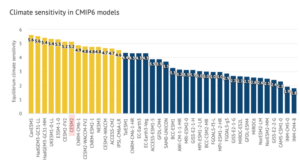by A. May, July 8, 2021 in WUWT
In Part 1, we introduced the concepts of climate sensitivity to CO2, often called ECS or TCR. The IPCC prefers a TCR of about 1.8°C/2xCO2 (IPCC, 2013, p. 818). TCR is the short-term, century scale, response of surface temperature to a doubling of CO2, we abbreviate the units as “°C/2xCO2.” In these posts we review lower estimates of climate sensitivity, estimates below 1°C/2xCO2. In parallel, we also review estimates of the surface air temperature sensitivity (SATS) to radiative forcing (RF, the units are °C per W/m2 or Watts per square meter). The IPCC estimates this value to be ~0.49°C per W/m2.
The previous post discussed two modern climate sensitivity estimates, by Richard Lindzen and Willie Soon, that range below 1°C/2xCO2. Next, we review climate sensitivity estimates by Sherwood Idso, Reginald Newell and their colleagues.
Many comments to part 1 tried to discredit the “ECS” or “TCR” estimates made by Lindzen and Soon, completely missing their point and my point. ECS and TCR are artificial climate model constructs, with little meaning outside the confines of computer modeling. TCR is a little more realistic since we might be able to observe or measure something close to it over the next century. But ECS, or the “Equilibrium Climate Sensitivity” is a totally abstract and unworldly number that could never be measured. It means if CO2 doubled suddenly, and nothing else changed for several hundred years while the oceans came into equilibrium with the new surface air temperature, what would the final surface temperature be? Air temperature would never be close to equilibrium for several hundred years, even 70 to 100 years (TCR) is a stretch.
Climate models are not the real world and the numbers that come out of them, like ECS or TCR, can be useful for showing the likely direction of temperature movement in response to changes in parameters or different model scenarios, but the numbers themselves are meaningless unless the models have previously been validated against the real world. With the possible exception of the Russian INM-CM4 model, no other IPCC model has successfully predicted future global surface temperatures. Ron Clutz discusses INM-CM4 here.
Model calculations are not observations. ECS and TCR are not real numbers, real numbers are based on observations. Thus, the model extracted values of ECS and TCR are not information, they can be used to detect the direction of change in climate forcing, if the climate model is an accurate reflection of that portion of the real world. The direction of movement of ECS and TCR, when model parameters or data tables change, is the information, not the computed value. I’m often amazed, as a former petrophysical modeler of 42 years, how often otherwise intelligent people confuse unvalidated model calculations with observations.
…


